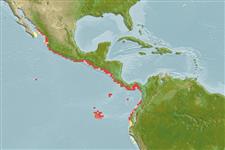>
Eupercaria/misc (Various families in series Eupercaria) >
Lutjanidae (Snappers) > Lutjaninae
Etymology: Lutjanus: Malay, ikan lutjan, name of a fish.
More on author: Gilbert.
Environment: milieu / climate zone / depth range / distribution range
Ökologie
seewasser riff-verbunden; tiefenbereich 0 - 50 m (Ref. 55), usually 40 - 50 m (Ref. 9313). Tropical; 26°N - 10°S, 110°W - 77°W (Ref. 55)
Eastern Pacific: southern Mexico to Peru, including the Mapelo, Cocos and Galapagos islands.
Size / Gewicht / Alter
Maturity: Lm ? range ? - ? cm
Max length : 60.0 cm TL Männchen/unbestimmt; (Ref. 9313)
Rückenflossenstacheln (insgesamt): 10; Rückenflossenweichstrahlen (insgesamt): 14; Afterflossenstacheln 3; Afterflossenweichstrahlen: 9. Head pointed, dorsal profile of forehead somewhat angular. Preorbital bone broad, maxilla extending nearly to mid-eye level. Preopercular notch and knob well developed. Scale rows on back parallel to lateral line. Upper back and top of head dark olive; sides and ventral parts dark purplish; silvery spots on side forming longitudinal rows.
Adults are found over hard bottoms in inshore reef areas. They form schools in surface waters around Cocos Island, Costa Rica (Ref. 9313). Carnivorous, feed on invertebrates and fish (Ref. 9313).
Life cycle and mating behavior
Geschlechtsreife | Fortpflanzung | Ablaichen | Eier | Fecundity | Larven
Allen, G.R., 1985. FAO Species Catalogue. Vol. 6. Snappers of the world. An annotated and illustrated catalogue of lutjanid species known to date. FAO Fish. Synop. 125(6):208 p. Rome: FAO. (Ref. 55)
IUCN Rote Liste Status (Ref. 130435)
Bedrohung für Menschen
Harmless
Nutzung durch Menschen
Fischereien: kommerziell; Sportfisch: ja
Mehr Information
NamenSynonymeMetabolismusRäuberÖkotoxikologieFortpflanzungGeschlechtsreifeAblaichenSpawning aggregationFecundityEierEientwicklung
ReferenzenAquakulturAquakultur ProfilZuchtlinienGenetikElectrophoresesVererbbarkeitKrankheitenVerarbeitungNutrientsMass conversion
PartnerBilderStamps, Coins Misc.LauteCiguateraGeschwindigkeitSchwimmstilKiemenoberflächeOtolithsGehirngrößeSehfähigkeit
Tools
Zusatzinformationen
Download XML
Internet Quellen
Estimates based on models
Preferred temperature (Ref.
123201): 17.6 - 25.4, mean 20.8 °C (based on 5 cells).
Phylogenetic diversity index (Ref.
82804): PD
50 = 0.5000 [Uniqueness, from 0.5 = low to 2.0 = high].
Bayesian length-weight: a=0.01479 (0.00706 - 0.03101), b=2.97 (2.81 - 3.13), in cm total length, based on LWR estimates for this Genus-body shape (Ref.
93245).
Trophic level (Ref.
69278): 4.5 ±0.8 se; based on diet studies.
Widerstandsfähigkeit (Ref.
120179): mittel, Verdopplung der Population dauert 1,4 - 4,4 Jahre. (Preliminary K or Fecundity.).
Fishing Vulnerability (Ref.
59153): Moderate vulnerability (44 of 100).
Climate Vulnerability (Ref.
125649): Very high vulnerability (86 of 100).
Nutrients (Ref.
124155): Calcium = 29.3 [17.9, 44.4] mg/100g; Iron = 0.338 [0.215, 0.553] mg/100g; Protein = 18.6 [17.1, 19.9] %; Omega3 = 0.13 [0.09, 0.19] g/100g; Selenium = 56.4 [33.7, 91.5] μg/100g; VitaminA = 222 [43, 884] μg/100g; Zinc = 0.352 [0.267, 0.501] mg/100g (wet weight);
